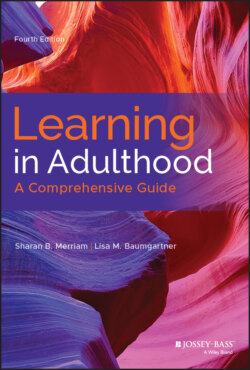Читать книгу Learning in Adulthood - Sharan B. Merriam - Страница 19
Chapter 2 Adult Learning and Technology
ОглавлениеTechnology is embedded in our lives. Some of us may no longer hail a taxi, but instead use an app on our phone to request a pickup from a shared ride service. We can use YouTube to learn how to knit, how to negotiate a salary, and how to fix a leaky bathroom faucet. We don't need a cashier to total up our grocery bill as stores have self-checkout machines. Drones help farmers check on crops and livestock and they help assess damage after a storm. Teaching technologies have also evolved. Students use clickers to respond to multiple-choice questions presented by the teacher instead of raising their hands. Material that used to be presented on the overhead projector is now shown via YouTube video, Prezi, Animoto, or PowerPoint. As we discuss later in the chapter, the way courses are delivered has been changed by technology. Companies such as the Khan Academy offer online courses to supplement K-12 curriculum as well as courses in college test preparation, personal finance, and entrepreneurship (Khan Academy, 2019). In addition, the “flipped classroom” utilizes blended instruction where some course content such as videos or a podcast are viewed or heard outside of class time and activity-based instruction such as solving math problems is accomplished in class (Moffett, 2015). King (2017) lists common uses of technology in Table 2.1.
Table 2.1 Common Uses of Technology
SOURCE: King, 2017, pp. 30–31.
| Reserving airline tickets, hotel rooms, car rentals, vacations, and so on | Maintaining a personal calendar |
| Accessing health-related information | Filing income tax |
| Reading books | Taking an online class |
| Online shopping | Learning how to do something new |
| Watching television and movies (live and on demand) | Tracking investments |
| Listening to music | Trading stocks |
| Checking the weather | Researching the next car |
| Hunting for an apartment or house | Finding a date or mate |
| Communicating with friends and family | Communicating work-related information |
| Sending pictures to friends and family | Sending birthday “cards” |
Technology has always changed people's lives. Gutenberg's printing press, for example, “expanded the number of words available… [which] increased the depth and breadth of communication” (Parker, 2014, p. 223). Multiple copies of materials could be delivered to learners, so the consistency of knowledge increased. Fast-forward to the early 1990s when personal computers became more reasonably priced and the use of the Internet moved beyond the scientific community to more commercial use. The ability to create and share knowledge increased exponentially. Technology continues to enhance learner engagement.
Technology also drives how students experience education at a distance. Correspondence courses were delivered via mail and then by radio and television. Later, two-way synchronous communication between the teacher and learner was accomplished via telephone and interactive television. As online instruction has increased, so have discussions concerning online learning theory, online course designs, and devices on which this instruction is delivered, including tablets and mobile telephones. Scholars have also explored the best practices for teaching online and in blended courses, and they have also predicted how technology will continue to change the learning landscape.
This attention to online learning is warranted as participation in online learning is rising. In the academic year 2015–2016, 42.9% of undergraduates had taken distance education courses (National Center for Education Statistics, 2019b) compared to 20% in 2008 (Radford, 2011). Eighty-three percent of the students taking distance education courses in the higher education context are undergraduates (Allen & Seaman, 2017). Individuals may also take web-facilitated or blended courses. See Table 2.2 for definitions of online learning.
Table 2.2 Definitions of Types of Online Learning
SOURCE: King, 2017, p. 207.
| Proportion of content delivered online (%) | Type of course | Typical description |
| 0 | Traditional | Course with no online technology used—content is delivered in writing or orally |
| 1–29 | Web facilitated | Course that uses web-based technology to facilitate what is essentially a face-to-face course; may use a course management system (CMS) or web pages to post the syllabus and assignments |
| 30–79 | Blended or hybrid | Course that blends online and face-to-face delivery; substantial proportion of the content is delivered online, typically using online discussions, and typically has a reduced number of face-to-face meetings |
| 80–100 | Online | A course in which most or all of the content is delivered online; typically has no face-to-face meetings |
Technology in adult education is a broad topic. Authors have written books on adult learning and technology (Bryan & Wang, 2013; Kidd, 2009; King, 2017). In this chapter, we provide a brief overview of the history of distance education. This is followed by popular online learning theories. We review the challenges of and best practices for online learning as well as the place of technology in our everyday, informal learning. We conclude the chapter by examining the future of technology in adult education.
